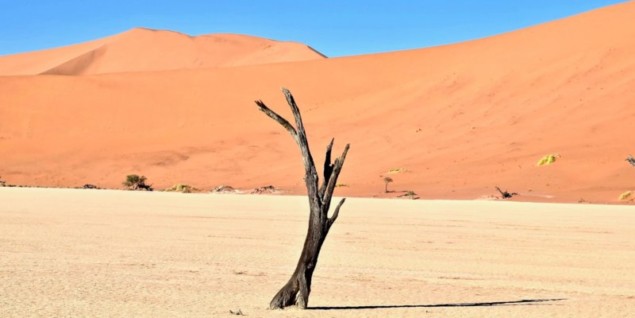
By 2100, climate impacts will be felt by everyone and most people will experience at least three simultaneous hazards, inexorably made more hazardous by the build-up of greenhouse gases in the atmosphere.
And they could be the lucky ones: some people could be menaced by six different kinds of warming-related hazard simultaneously.
Camilo Mora of the University of Hawaii at Manoa and 22 colleagues report in Nature Climate Change that they read systematically through 3280 peer-reviewed papers on the subject of climate change, and compiled a matrix of 467 ways in which 10 major climate hazards – floods, droughts, heat waves, fires and so on – and six aspects of human dependency (health, food, water, etc.) could affect humanity.
They did, they say, identify some positive or neutral effects, but the overwhelming majority of climate impacts would create problems for human communities and their economies.
Medical prospects
Mora has established a reputation for thinking on the scale of global catalogue. Recently, the geographer and his fellow researchers looked at medical records and heat extremes and listed 27 different ways in which heat waves could kill.
In recent years he has been involved in studies that have tried to measure the challenge to the global harvest because of carbon dioxide accretion in the atmosphere as a consequence of fossil fuel combustion; the first years in which particular locations around the world could feel the impact of irreversible climate change; and then the proportion of humans at risk from heat extremes by the end of the century.
The latest study concludes that even if greenhouse gas emissions are dramatically reduced, most of the world would still be confronted by one hazard at a time: the worldwide average temperature rise of 1 °C has already started to change climates and heighten climatic extremes.
And if humans go on burning fossil fuels in what has become notorious as the business-as-usual scenario, then almost everybody could face three hazards at the same time. In some coastal regions some people could be hit by six.
The evidence of climate change impacting humanity is abundant, loud and clear … How many wake-up calls will it take to wake up?
Daniele Spirandelli
Higher atmospheric temperatures accelerate the evaporation of soil water. Normally dry places will be at risk of drought, heatwave and wildfire. Normally rainy places will face catastrophic downpour, and flood. Warmer ocean waters will evaporate at greater rates, so windspeed and rainfall from hurricanes will also increase. Sea level rise driven by water temperatures, and by glacial melting, will raise the risk of coastal flooding and storm surges.
Some of these impacts have already affected human health, bringing death, disease and mental illness. They have affected the supply of food on land and at sea; they have damaged electrical supplies, transportation, water and sewage infrastructure; they have damaged property and reduced labour productivity; they have triggered migration and sparked violence, and Mora and his colleagues have now compiled a database of more than 3000 documented examples.
“Greenhouse gas emissions pose a broad threat to humanity by simultaneously intensifying many hazards that have proved harmful in the past,” says Mora.
“Further, we predict that by 2100 the number of hazards occurring concurrently will increase, making it even more difficult for people to cope.”
List of impacts
The latest study simply looks at all the recent climate impacts recorded and assessed and categorises them in a range of ways.
These include the 33% loss of grain to drought and fire in Russia in 2010; the loss of three-fourths of all livestock during drought in Kenya in 2000; drinking water shortages for 33 million people in China in 2001; the rise in waterborne infectious diseases after the 2010 Indus floods overwhelmed sewage treatment plants in Pakistan; the cumulative damage by flood and storm to millions of homes in China, Pakistan, Bangladesh, Indonesia, the US and France; and – because of melting ice – the forced relocation of Inuit villages in Alaska.
Heatwaves caused blackouts for 670 million people in India in 2012, and 35 million in Saudi Arabia in 2010. After Hurricane Andrew in 1992 hammered the US east coast, a total of 12 insurance companies went bust.
The next step, having assembled the possible kinds of impact, was to model the way they would be amplified and intensified under various scenarios for global warming. Wealth and economic power offer no great protection. New York can expect at worst by 2100 to face at least four hazards; Sydney and Los Angeles three; Mexico City four, and the Atlantic coast of Brazil five.
Present danger
“The collision of cumulative climate hazards is not something on the horizon, it is already here,” Mora says. “Co-occurring and colliding climate hazards are already making headlines worldwide.
“Last year, for instance, Florida recorded extreme drought, record high temperatures, over 100 wildfires, and the strongest-ever recorded hurricane in its Panhandle: the category 4 Hurricane Michael.
“Likewise, California is currently experiencing ferocious wild fires and one of the longest droughts, plus extreme heatwaves this past summer.”
“The evidence of climate change impacting humanity is abundant, loud and clear,” says his co-author and colleague Daniele Spirandelli. “Clearly, the outstanding question is − how many wake-up calls will it take to wake up?”
- This article first appeared at Climate News Network.



